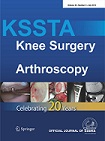
Arthroplasty
Closure of knees in flexion versus extension, and effect on ROM, function, and strength
Knee Surg Sports Traumatol Arthrosc. 2014 Dec;22(12):3067-7329 patients scheduled for total knee arthroplasty were randomized to have wound closure performed with the knee in flexion or extension. The purpose of this study was to evaluate whether there were any differences in knee range of motion, patient-reported function, or isokinetic strength between knees based on position of the knee during surgical closure. Results were assessed at 1 month postoperatively. Groups were observed to not significantly differ in knee ROM and function or absolute isokinetic strength. When strength difference between the operated knee and contralateral knee was compared between groups at 180deg/s, the group closed in flexion demonstrated favourable flexor strength. Extensor strength difference at 180deg/s was not significantly different between groups, and neither flexor or extensor strength was different at 60deg/s.
Unlock the full article
Get unlimited access to OrthoEvidence with a free trial
Start TrialCritical appraisals of the latest, high-impact randomized controlled trials and systematic reviews in orthopaedics
Access to OrthoEvidence podcast content, including collaborations with the Journal of Bone and Joint Surgery, interviews with internationally recognized surgeons, and roundtable discussions on orthopaedic news and topics
Subscription to The Pulse, a twice-weekly evidence-based newsletter designed to help you make better clinical decisions
Exclusive access to original content articles, including in-house systematic reviews, and articles on health research methods and hot orthopaedic topics
Or continue reading this full article
Register Now

Subscribe to "The Pulse"
Evidence-Based Orthopaedics direct to your inbox.




































